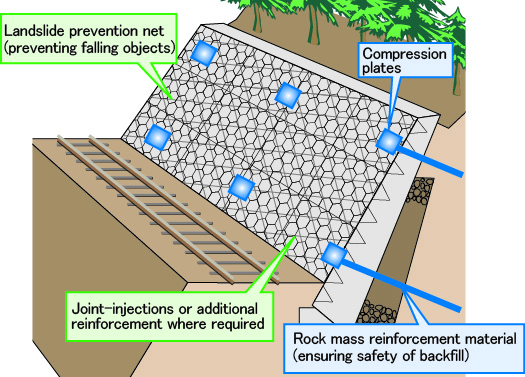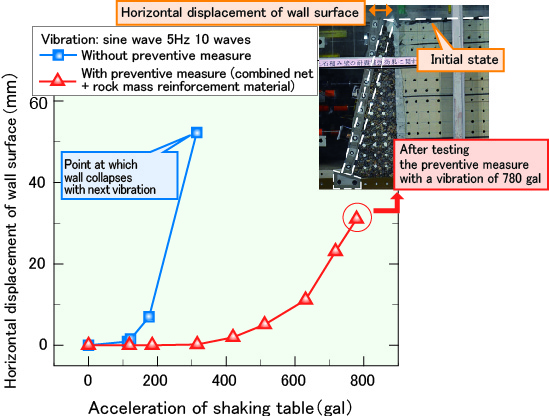4. Work method to increase seismic resistance of masonry walls combining landslide prevention netting and rock mass reinforcement materials
- A new method was developed to improve the seismic resistance of masonry walls based on a combination of landslide prevention nets and rock mass reinforcement material.
- Trials on a shaking test bench with doubled landslide acceleration demonstrated that the developed method is an effective means to increase seismic resistance.
- A design manual was produced to accompany this work method.
There are approximately 200,000 earth retaining walls across Japan, of which around 40% are masonry walls. Work to improve the seismic resistance of these walls to prepare for a large scale earthquake therefore urgently needs to begin. As such, a new method was developed to improve the seismic resistance of masonry walls based on a combination of landslide prevention nets and rock mass reinforcement material.
Masonry earth retaining walls do not form a single integrated structure. Consequently, if rocks in the structure become lose during a large scale earthquake, this can lead to overall collapse of the wall. Up until today, even when using rock mass reinforcement materials、traditional reinforcement methods have either used steel reinforced concrete which is injected into the wall to reinforce overall cohesion of the structure or it has been necessary to inject a high density of rock mass reinforcement material. Large scale application of any of these two methods however has always been a problem. A new method to improve the seismic resistance of these structures was therefore devised. This new method combines anti-rockfall netting attached to the front of the retaining wall with rock mass reinforcement material which is injected behind the wall to stabilise the backfill (Fig.1).
Results of tests on a shaking table to verify the effectiveness of the reinforcement method gave the following results: Without the preventive measures, the wall and backfill underwent significant change at a vibration acceleration speed of 300 gal and at 400 gal the wall collapsed. However, with the preventive measure, the wall only displayed minor alteration even at 800 gal and under conditions reproducing a major L2 earthquake the netting prevented loss of any masonry while the seismic resistance of the backfill was demonstrably improved by virtue of the rock mass reinforcement material.(Fig.2) Furthermore, analysis of the test results provided insight into the mechanisms which reinforced the structure, and a manual was compiled containing guidelines on application of this reinforcement method in practice.

Fig. 1 Work method to increase seismic resistance
of masonry walls combining landslide prevention netting
and rock mass reinforcement materials
Fig.2 Relationship between horizontal displacement of wall
and acceleration of shaking table